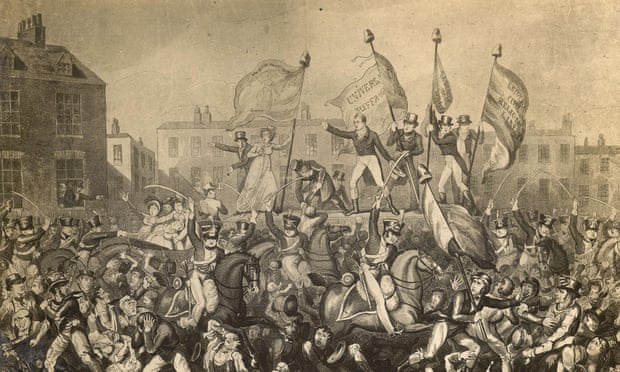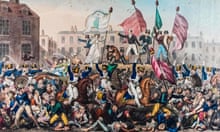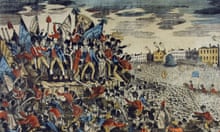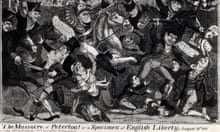Thousands of people are to take part in a huge re-enactment of the Peterloo massacre to mark the 200th anniversary of one of the defining moments in British political history.
Around 3,000 people will perform a “combination of giant karaoke and autocue” on Friday near the square in Manchester where 18 people were killed and more than 650 injured by a sabre-wielding cavalry on 16 August 1819.
The names of the dead will be read out at 1.30pm, the exact time when 200 years ago troops were ordered to break up the crowd of 60,000 protesters who had gathered peacefully to demand political reform.
Instead of a solemn civic ceremony, the event is designed to be an immersive, noise-filled show with a ticketed audience of 3,000 people but “no spectators, only performers”.
The performance is described as “a dialogue between 1819 and 2019” and is shaped around the contemporary words of protesters and poets, mixed with the witness testimonies of those present in 1819.
Descendants of those present 200 years ago will read out the names of the deceased, alongside public figures including Mike Leigh, the award-winning director whose film about Peterloo won rave reviews last year, and the film-maker Danny Boyle.
Su Bindless, a retired teacher, said she was “terrified” but felt privileged to read the name of her great-great-great-great-uncle, Edmund Dawson, an 18-year-old who was fatally sabred by the cavalry. “I think it’s very, very important. It’s amazing how many people don’t know about it but that’s not their fault – it’s always been a hidden part of history,” she said.
Bindless said it was “disgraceful” that Peterloo and its legacy was not taught in schools and that Manchester itself had neglected to properly acknowledge the impact of the massacre, which paved the way for parliamentary democracy.
Denise Southworth, a direct descendant of Mary Heys, one of the protesters who died, said the significance of that day had been “criminally neglected” in Manchester for 200 years.
A small plaque on the Radisson hotel was for years the only permanent memorial to the massacre. A £1m monument was quietly unveiled earlier this week despite continuing criticism about its lack of disability access.
“What annoys me is that it’s never, ever been recognised in Manchester,” said Southworth, whose ancestor was trampled by the cavalry and died later during childbirth.
Quick Guide What was the Peterloo massacre?
Show

What was the Peterloo Massacre and how many were killed?
On 16 August 1819, up to 60,000 working class people from the towns and villages of what is now Greater Manchester marched to St Peters Fields in central Manchester to demand political representation. Their peaceful protest turned bloody when Manchester magistrates ordered Yeoman – a private militia paid for by rich locals – to storm the crowd with sabres.
Most historians agree that 14 people were definitely killed in the massacre – 15 if you include the unborn child of Elizabeth Gaunt, killed in the womb after she was beaten by constables in custody. A further three named people are believed to have either been stabbed or trampled to death.
Why is it called Peterloo?
The name was first coined five days after the massacre by James Wroe, editor of the Manchester Observer, the city’s first radical newspaper (no relation to the Observer of today). According to historian Robert Poole, Peterloo was “a bitter pun, comparing the cowardly attacks by the Yeomanry and soldiers on unarmed civilians to the brutality suffered at Waterloo.”
What did the protesters want?
They wanted political reform. The years leading up to Peterloo had been tough for working class people and they wanted a voice in parliament to put their needs and wants on the political agenda, inspired by the French Revolution across the Channel. Machines had begun to take jobs in the lucrative cotton industry but periodic trade slumps closed factories at short notice, putting workers out on the street. The Napoleonic Wars, which ended in 1815 with the Battle of Waterloo, had taken a heavy toll on the nation’s finances, and 350,000 ex-servicemen returned home needing jobs and food. Yet those in power seemed more interested in lining their own pockets than helping the poor.
At that point, only the richest landowners could vote, and large swathes of the country were not represented in Westminster. Manchester and Salford, which then had a population of 150,000, had no MP, yet Oxford and Cambridge Universities had their own representation. At the time the extension of the vote to all men, let alone women, was actively opposed by many who thought the vote should be restricted to those of influence and means.
Why is Peterloo important?
It paved the way for parliamentary democracy and particularly the Great Reform Act of 1832 which created new parliamentary seats, particularly in the industrial towns of the north of England. It also led to the establishment two years later of the Manchester Guardian by John Edward Taylor, a 28-year-old English journalist who was present at the massacre and saw how the “establishment” media sought to discredit the protesters.
Helen Pidd, North of England editor
“We’ve got this tiny plaque on the hotel and it’s so high up you’d have to be about 8ft to see it. When you talk about the history of Manchester they will talk about the Arena, Manchester United, Manchester City – yeah, but what is it built on?
“Two hundred years ago people had to go through all that to get the laws changed. The sacrifices that had to be made ultimately led to the fact that we have some equality.”
As the last name is read out 18 bells will ring from Manchester’s neo-gothic town hall followed by a minute’s silence and the release of 18 ribbons of red smoke. Screens across the city will display all the names of the dead.
The new monument, designed by the Turner prize-winning artist Jeremy Deller, was expected to be unveiled formally on Friday but was made public without any fanfare on Tuesday afternoon, amid the criticism from disability rights campaigners.
The sculpture is designed to be a speakers’ podium of 11 concentric steps but will be modified to make it fully accessible, Manchester city council has said. There is deep anger at the council’s management of the issue. “I don’t think it’s been very well handled,” said Bindless. “It’s a great moment – there should have been a grand unveiling.”








